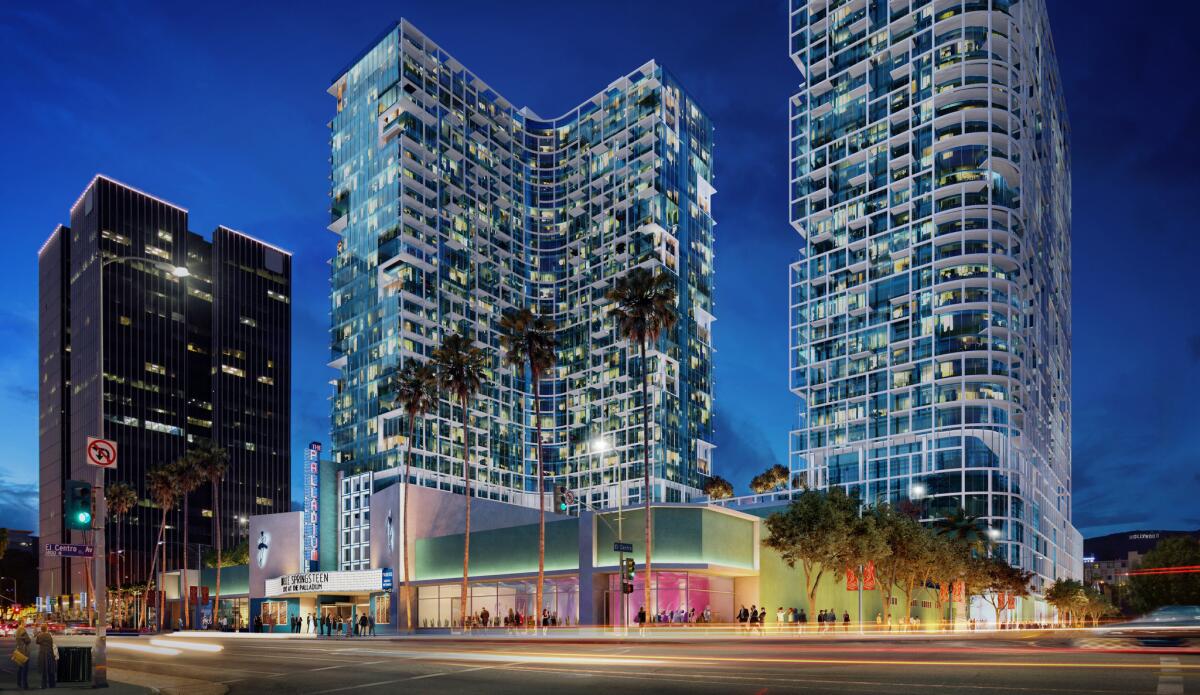Editorial: Make Hollywood a model for how L.A. can grow equitably

- Share via
For years, Hollywood has been ground zero for fights over development, density and how — and for whom — Los Angeles should grow.
Hollywood is both a community and a symbol of L.A., and it encapsulates many of the city’s challenges. It’s the entertainment capital with studios, theaters and swanky hillside homes. There’s huge demand to continue to transform Hollywood into an upscale, walkable urban center, with high-rise apartments, hotels and offices next to subway stations.
But Hollywood is also home to historic immigrant neighborhoods, mom-and-pop shops and many older, rent-stabilized apartments. The focus on Hollywood’s glitzy potential has left these working-class communities vulnerable to rising rents and evictions. Since 2000, there’s been an exodus of lower-income residents, most of them Latino, from the area.
Yolanda Lichtman is a longtime resident and a member of the Just Hollywood Coalition. She’s watched as pricey new apartment buildings and luxury hotels rise in her neighborhood while her congregation at the Blessed Sacrament Church has dwindled. “Less and less people come to the church because families have moved away. They cannot afford the rent in Hollywood,” she said.
Now, the Los Angeles Planning City Commission and the City Council have the opportunity to rethink how Hollywood should grow. The commission is expected to vote this week on a new Hollywood Community Plan, which will set new land-use rules for the area that stretches from Los Feliz to the hills above the Sunset Strip.
It’s clear that Hollywood must change. Los Angeles is in a housing crisis, after decades of failing to build enough housing to meet population needs. The city has to plan for 455,000 new units, including nearly 185,000 units for lower-income residents, by 2029. It makes sense to concentrate development in areas with good transit and jobs, like Hollywood.
This will be the city’s second attempt at a new Hollywood Community Plan. Neighborhood groups successfully sued to block a 2012 version that promoted tall buildings and intensified development around subway stations, or “elegant density,” as then-Mayor Antonio Villaraigosa called it.
If the 2012 plan was all about elegant density, then the 2021 version should be about equitable density. That is, Hollywood’s capacity should grow, but that growth should include lots of affordable housing with minimal displacement of existing residents. The new community plan makes good progress but could be made even stronger.
Because of the city’s outdated planning rules, developers have been allowed to negotiate valuable changes to land-use strictures on a case-by-case basis, which invites corruption. When developers were asked to provide affordable housing, it was usually a pittance. For example, in exchange for the zoning and land-use approvals needed to build two 28-story towers with 731 units behind the Palladium concert venue, a developer agreed to set aside 37 units — 5% of the total — for low to moderate-income tenants.
Under the new community plan, there would be clear rules on when developers would be required to include affordable units in exchange for building bigger. If the Palladium project were proposed under the new plan, the Planning Department says, the developer would be required to set aside between 106 and 218 units. (The exact number depends on how much bigger the developer wants to build and whether the apartments are designated for extremely low-income, low-income or moderate-income tenants.)
There’s already pressure to weaken the affordable housing requirements or make it easier for developers to build taller without having to include low-income units. That would be a mistake. Just 14% of current Hollywood tenants could afford a typical apartment there. If there’s any hope of ensuring working-class residents can still find a home in Hollywood, the city has to make sure new development includes affordable units.
The city also has to enshrine tenant protections and anti-displacement strategies within Hollywood’s land-use rules. The plan should discourage the redevelopment of buildings under rent control, but if it happens, the developer of the new apartment building should be required to replace the rent-controlled units and provide the requisite number of affordable units. There should be no net loss of units subject to rent control.
After years of fights over development, perhaps now Hollywood could be the model for how L.A. can grow more equitably.
More to Read
A cure for the common opinion
Get thought-provoking perspectives with our weekly newsletter.
You may occasionally receive promotional content from the Los Angeles Times.










